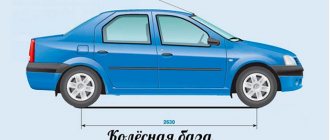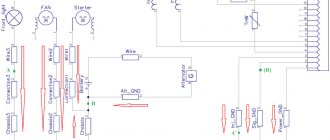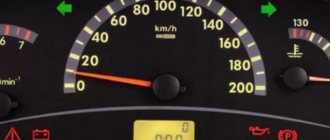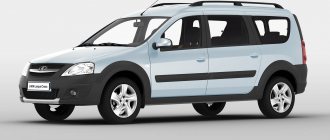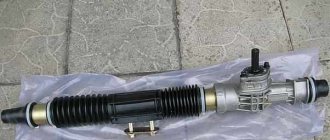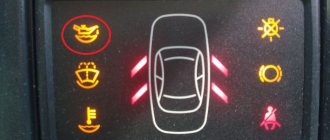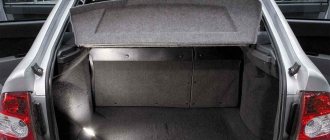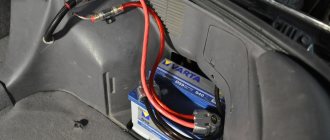The VAZ 2110 car was produced from 1995 to 2007. This sedan was created on the basis of the Lada 2108 hatchback. The dimensions of the VAZ 2110 differ slightly from the overall dimensions of the 21099 model. In particular, the length of the VAZ 2110 is only 6 cm longer than the length of the only sedan from the Lada Samara model range.
The length of the wheelbase is 3.2 cm longer, the height of the car is 1.8 cm, and the ground clearance of the loaded “ten” is 5 cm higher than that of the ninety-ninth. The front and rear wheel tracks of these sedans are the same. The same engines and gearboxes were installed on both cars.
However, despite all this, the technical characteristics of cars 2110 and 21099 are somewhat different. Despite its greater weight, the VAZ 2110 develops a higher maximum speed and shows better maneuverability thanks to smooth body lines and more advanced control systems. Undoubtedly, the VAZ 2110 is the best car produced at the Volzhsky Automobile Plant in the 90s.
Technical characteristics of the VAZ 2110 “Ten”
Four-door front-wheel drive sedan. Produced at AvtoVAZ from 1995 to 2007.
The first VAZ-2110s were produced on June 27, 1995 in AvtoVAZ pilot production, mass production began in August 1996, and sales began in November of the same year. By that time, technology in the global automotive industry had reached a new level, and the breakthrough model for the late 80s could no longer be called an absolute novelty. However, despite this, as well as some complaints about the quality of production in the 90s, it still became a step forward for the domestic automobile industry.
Unlike the Lada and Samara, the VAZ-2110 was positioned as a higher-class car, quite modern and competitive both externally and internally. In particular, an electronic engine control system was installed on the car (although the first VAZ-2110s were carburetor) and a diagnostic unit (on-board computer), it was possible to install power steering and electric windows, galvanized metal was used in body parts, and a new painting technology was used bodies, etc. The appearance of the “ten” marked a new stage in the development of the domestic automobile industry.
In March 2007, on the main assembly line of AvtoVAZ, serial production of cars of the new LADA Priora family was launched, which was a deep restyling of the “tens” and designed to replace the last one in the model range, and the “tens” were produced in parallel. The last set of VAZ-2110 was assembled on the Togliatti assembly line on October 15, 2007. VAZ-2111 (station wagon) and VAZ-2112 (hatchback) were produced for another two years and a year, respectively.
Until 2014, VAZ-2110s were assembled under license from AvtoVAZ vehicle kits at the Bogdan Corporation automobile plant in the Ukrainian city of Cherkassy under the Bogdan brand. A pickup truck based on the VAZ-2110 was also developed.
VAZ 2110
"Ten"
Performance characteristics of the VAZ 2110 ten
- Maximum speed: 180 km/h
- Acceleration time to 100 km/h: 12.5 s
- Fuel consumption per 100 km in the city: 8.8 l
- Fuel consumption per 100 km on the highway: 5.5 l
- Fuel consumption per 100 km combined cycle: 7.2 l
- Gas tank volume: 43 l
- Vehicle curb weight: 1040 kg
- Permissible gross weight: 1495 kg
- Tire size: 175/60 R14
- Rims size: 5Jx13
Engine characteristics
- Location: front, transverse
- Engine capacity: 1500 cm3
- Engine power: 94 hp
- Number of revolutions: 5600
- Torque: 128/3600 N*m
- Power system: Distributed injection (multipoint)
- Turbocharging: no
- Gas distribution mechanism: DOHC
- Cylinder arrangement: In-line
- Number of cylinders: 4
- Cylinder diameter: 82mm
- Stroke: 71 mm
- Compression ratio: 9.5
- Number of valves per cylinder: 4
- Recommended fuel: AI-95
Brake system
- Front brakes: Disc
- Rear brakes: Drum
Steering
Steering Type: Rack and Pinion
Transmission
- Drive: Front
- Number of gears: manual transmission - 5
6. Suspension
- Front suspension: independent, spring
- Rear suspension: semi-independent, spring
7. Body
- Body type: sedan
- Number of doors: 4
- Number of seats: 5
- Machine length: 4265 mm
- Machine width: 1680 mm
- Machine height: 1420 mm
- Wheelbase: 2492 mm
- Front track: 1400 mm
- Rear track: 1370 mm
- Ground clearance (clearance): 170 mm
- Trunk volume: 450 l
Production
Year of manufacture: from 1996 to 2007
Body reliability
Even if compared with the same VAZ cars - eights and nines, the bodies of the VAZ Lada 2110 are more reliable and resistant to corrosion. All-metal, made of metal with good performance, having partially galvanized parts, the bodies come off the assembly line with factory anti-corrosion treatment.
However, we should also pay tribute to our car owners. They, remaining adherents of domestic technology, despite all its shortcomings, themselves take care that the bodies serve for a long time and reliably. Therefore, they almost always add their own to the standard anti-corrosion treatment.
And then they also make sure that it is in place, and if necessary, they “touch up” the bottom of the car, treat the sills, fender liners, etc. with Movil. And although the oldest VAZ 2110 is already more than fifteen years old, you are unlikely to find completely rusty ones among them, because their owners love and cherish them.
Weight of VAZ 2110 bodies
Model body weight:
Body weight of modifications of the VAZ 2110 sedan (1995 – 2009):
- 1010 kg, 1020 kg, 1100 kg, 1330 kg.
Model body information:
The body of the VAZ 2110 is load-bearing and has a closed power structure, that is, it forms a closed contour (due to the presence of a roof) and brings together all vertical power elements.
All parts of the VAZ 2110 body are made by stamping from low-carbon, thin-sheet steel (thickness from 0.7 mm to 0.9 mm), heavily loaded parts are made from sheet 1.2 mm thick.
Important: according to the technical documentation, one of the heaviest bodies is the VAZ 2110 21109 Consul 1.5 MT sedan, its weight is 1330 kg.
Other names:
Until 2014, the VAZ 2110 model was assembled under license from AvtoVAZ vehicle kits at the Bogdan Corporation automobile plant under the Bogdan-2110 brand.
Subtleties of the model range:
The model is equipped with an electronic engine control system, a diagnostic unit (on-board computer), power steering, electric windows, and a new body painting technology is used.
Years of production Years of production: 1995-2007.
| Body weight VAZ 2110 | |
| Parameter | Meaning |
| 02 l., Petrol, Mechanics, 5 speed, Front | |
| Curb weight: | 1100 (kg) |
| Bare weight: | 275-330 (kg) |
| Permissible gross weight: | 1525 (kg) |
| 1.3 l., Petrol, Mechanical, 5 speed, Front | |
| Curb weight: | 1010 (kg) |
| Bare weight: | 250-300 (kg) |
| Permissible gross weight: | 1485 (kg) |
| 1.5 l., Petrol, Mechanical, 5 speed, Front | |
| Curb weight: | 1050 (kg) |
| Bare weight: | 275-330 (kg) |
| Permissible gross weight: | 1525 (kg) |
| 1.6 l., Petrol, Mechanical, 5 speed, Front | |
| Curb weight: | 1040 (kg) |
| Bare weight: | 250-300 (kg) |
| Permissible gross weight: | 1515 (kg) |
Caution: the data presented separately for the body are indicative, and may differ from the real ones by 15% in one direction or the other.
Characteristics of VAZ 2110
The VAZ 2110, or Lada 110, is a four-door sedan equipped with front-wheel drive and distinguished by a design that is different from other models. AvtoVAZ began production of the Lada 110 in 1996 and ended in 2007, but the Ukrainian LuAZ plant is still producing the car under the Bogdan brand.
Simultaneously with the Lada 110, several modifications were produced: engines with 8 and 16 valves. The maximum speed of the car increased to 170 and 180 km/h on 8-valve and 16-valve engines, respectively. The VAZ 2110 has excellent technical characteristics that allow the car to be used in almost any conditions.
The VAZ 2110 is the upper price segment in the AvtoVAZ car line, so it has a number of new and useful features: an immobilizer, an on-board control system with a diagnostic unit, a gasoline vapor detection system, electric lifts and power steering.
Characteristics of VAZ 2110
| Engine | 1.6 l, 8kl (Euro-2) | 1.6 l, 16cl (Euro-2) | 1.6 l, 16cl (Euro-3) |
| Length, mm | 4265 | 4265 | 4265 |
| Width, mm | 1680 | 1680 | 1680 |
| Height, mm | 1420 | 1420 | 1420 |
| Base, mm | 2492 | 2492 | 2492 |
| Front wheel track, mm | 1410 | 1410 | 1410 |
| Rear wheel track | 1380 | 1380 | 1380 |
| Load capacity, kg | 475 | 475 | 475 |
| Luggage compartment volume, dm3 | 450 | 450 | 450 |
| Permissible total weight of a towed trailer with brakes, kg | 1000 | 1000 | 1000 |
| Permissible total weight of a towed trailer without brakes, kg | 500 | 500 | 500 |
| Wheel formula / drive wheels | 4x2 / front | ||
| Car layout diagram | Front-wheel drive, front engine, transverse | ||
| Body type / number of doors | Sedan/4 | ||
| engine's type | injection gasoline, four-stroke | ||
| Engine displacement, cm3 | 1596 | 1596 | 1596 |
| Supply system | distributed injection with electronic control | ||
| Number and arrangement of cylinders | 4, in-line | ||
| Maximum power, kW (hp) / rev. min. | 59 (80) / 5200 | 65,5 (89) / 5000 | 65,5 (89) / 5000 |
| Maximum torque, Nm at rpm | 120 / 2700 | 131 / 3700 | 131 / 3700 |
| Maximum speed, km/h | 170 | 180 | 180 |
| Fuel consumption by driving cycle, l/100 km | 7,2 | 7,2 | 7,2 |
| Fuel | AI-92 (min) | AI-92 (min) | AI-92 (min) |
| Transmission | mechanical | ||
| Number of gears | 5 forward, 1 reverse | ||
| Main gear ratio | 3,7 | 3,7 | 3,7 |
| Acceleration to 100 km/h, s | 13,5 | 12 | 12 |
| Steering | with hydraulic booster, rack and pinion steering mechanism | ||
| Tires | 175/65 R13 | 175/65 R13 | 175/65 R14 185/60 R14 |
| Fuel tank capacity, l | 43 | 43 | 43 |
Modifications of VAZ 2110
- VAZ-21100 (8-valve petrol carburetor engine with a working volume of 1.5 liters was produced from 1996 to 2000);
- VAZ-21101 (8-valve gasoline injection engine with a working volume of 1.6 liters, produced since 2004);
- VAZ-21102 (8-valve gasoline injection engine with a working volume of 1.5 liters);
- VAZ-21103 (16-valve gasoline injection engine with a working volume of 1.5 liters, produced since 2001);
- VAZ-21103M (16-valve gasoline injection engine with a working volume of 1.5 liters, produced since 2001);
- VAZ-21104 (16-valve petrol injection engine with a working volume of 1.6 liters, produced since 2004);
- VAZ-21104M (16-valve gasoline injection engine with a working volume of 1.6 liters, produced since 2004);
- VAZ-21106 GTI 2.0 16V (16-valve Opel C20XE petrol engine with a displacement of 2.0 liters);
- VAZ-21106 Coupe (variation of a car in a coupe body);
- VAZ-21107 (Sports modification of the VAZ-21106 car);
- VAZ 21108 “Premier” (extended by 17.5 cm, has additional handles on the rear doors, enhanced sound insulation);
- VAZ 21109 “Consul” (limousine with five doors, a glass roof and an interior made of wood; non-serial production);
- VAZ 2110 RPD (Sports variation of the VAZ-2110 car with a rotary piston engine).
In 2002, MAI specialists developed the VAZ 2110 with a continuously variable transmission (VT1 variator).
From 2005 to 2007, only modifications 21101 and 21104 were produced.
Car history
In addition to the fact that the body of the Lada of the tenth family had smooth lines and was not at all similar to the body of the already boring “99th” model, the 110th model was able to introduce an abundance of new elements that had not previously been seen on vehicles produced by the Volzhsky Automobile Plant. Among the innovations are the presence of an adjustable steering wheel, glued windows, gas hood supports and air conditioning.
After they began installing a sixteen-valve power unit on the VAZ-2110, it became clear to everyone that “it’s better not to joke with Tazami,” since the car could even leave some foreign cars behind. The “Ten” was produced with three versions of equipment: standard, norm and luxury. Despite the stoppage of production of the VAZ-2110 in the Russian Federation, the model is still produced in Ukraine today as the Bogdan 2110.
Work on the design of the dozen began back in 1983. The very first car of this class was supposed to be a sedan with a rear-wheel drive layout. But the developments were never able to reach their own finish line. A little later, the company decided to start developing a vehicle on the VAZ-2108 platform.
However, the cost of this machine was exorbitant, so the developers decided to freeze this project as well. Over time, all the developments resulted in the VAZ-21099 car. At the first time of production, the car came with a carburetor power system, and after 2000 they decided to install distributor fuel injection (injector).
Modifications
| Name | Year of issue | |
| LADA 110 (2110) 1.5 | 01.1995 — 12.2005 | Characteristics |
| LADA 110 (2110) 1.5 | 01.1995 — 12.2005 | Characteristics |
| LADA 110 (2110) 1.5 16V | 01.1995 — 12.2005 | Characteristics |
| LADA 110 (2110) 2.0 i | 08.1996 — 07.2000 | Characteristics |
| LADA 110 (2110) Wankel | 06.1997 — 09.2004 | Characteristics |
| LADA 110 (2110) 1.5 | 10.2000 — 12.2005 | Characteristics |
| LADA 110 (2110) 1.5 16V | 10.2000 — 12.2010 | Characteristics |
| LADA 110 (2110) 1.6 | 01.2000 — 12.2012 | Characteristics |
| LADA 110 (2110) 1.6 | 01.2000 — 04.2007 | Characteristics |
Technical characteristics of VAZ 2110
| Automobile | Lada 2110 | ||||
| Modification name | VAZ-2110 | VAZ-21102 | VAZ-21103 | VAZ-21101 | VAZ-21104 |
| Body type | sedan | ||||
| Number of places | 5 | ||||
| Length, mm | 4265 | ||||
| Width, mm | 1680 | ||||
| Height, mm | 1420 | ||||
| Wheelbase, mm | 2492 | ||||
| Curb weight, kg | 1010 | 1020 | 1050 | 1020 | 1040 |
| engine's type | petrol | petrol, fuel injection | petrol, fuel injection | petrol, fuel injection | petrol, fuel injection |
| Location | front, longitudinal | front, longitudinal | front, longitudinal | front, longitudinal | front, longitudinal |
| Number and arrangement of cylinders | 4, in a row | 4, in a row | 4, in a row | 4, in a row | 4, in a row |
| Working volume, cubic meters cm. | 1499 | 1499 | 1499 | 1596 | 1596 |
| Number of valves | 8 | 8 | 16 | 8 | 16 |
| Maximum power, l. With. / rpm | 73 / 5600 | 78 / 5400 | 93 / 5600 | 81 / 5200 | 89 / 5000 |
| Maximum torque, Nm / rpm | 109 / 3400 | 116 / 3000 | 128 / 3700 | 120 / 2700 | 131 / 3700 |
| Transmission | manual, 5-speed | ||||
| Drive unit | front | ||||
| Tires | 175/70 R13 | 175/65 R14 | 175/70 R13 | 175/65 R14 | |
| Maximum speed, km/h | 165 | 170 | 185 | 170 | 180 |
| Acceleration time 0-100 km/h, s | 14 | 14 | 12,5 | 13,5 | 12 |
| Fuel consumption in the combined cycle, l/100 km | 7,6 | 7,2 | 7,2 | 7,5 | 7,2 |
| Fuel tank capacity, l | 43 | ||||
| Fuel type | petrol | ||||
Review of VAZ-2110
The VAZ-2110 sedan has been produced since 1995.
Initially, the car was equipped with a 1.5 liter eight-valve carburetor engine. Subsequently, only injection engines were installed on the “ten”: 1.5-liter eight-valve (modification VAZ-21102) or 16-valve (21103); 1.6-liter eight-valve (21101) or 16-valve (21104). In addition to the sedan, versions with hatchback (VAZ-2112) and station wagon (VAZ-2111) bodies were also produced. In 2007, after the appearance of the Priora, the production of the “ten” in Tolyatti was curtailed. However, their production continued in Ukraine from vehicle kits supplied by AvtoVAZ. In 2010, sales of Ukrainian-assembled cars began in Russia under the name “Bogdan 2110” (on the Ukrainian market the car is sold under the Lada brand).
Source
- wroom.ru/cars/lada/2110#1
- autodelo.info/catalog/auto/model/1993/
- wikiweight.info/tehnika/kuzova/massa-kuzovov-vaz-2110.html
- zen.yandex.ru/media/id/5d42cf85f0d4f400ae3f3ecf/tehnicheskie-harakteristiki-vaz-2110-desiatka-5d45b901fbe6e700adf3f88d
- carexpert.ru/models/vaz/2110/tech/vaz100s.htm
Driver reviews
Most drivers who have ever owned or continue to use a VAZ-2110 to this day say that the car is inexpensive to operate and repair, has good front-wheel drive, starts up despite low temperatures, and is also the best car for a beginner. Also, the domestic vehicle turned out to be quite economical and simple.
However, at the same time, many car enthusiasts do not like the low seating position, poor-quality assembly, the need to constantly monitor the timing belt, the creaking sounds of the front plastic panel, low comfort, frequent breakdowns, small internal dimensions of the VAZ-2110, and so on.
Among the domestic automobile industry, the VAZ-2110 is a pretty good model, but until 2007, because it was after this year that the Volzhsky Automobile Plant began to produce a more improved car.
